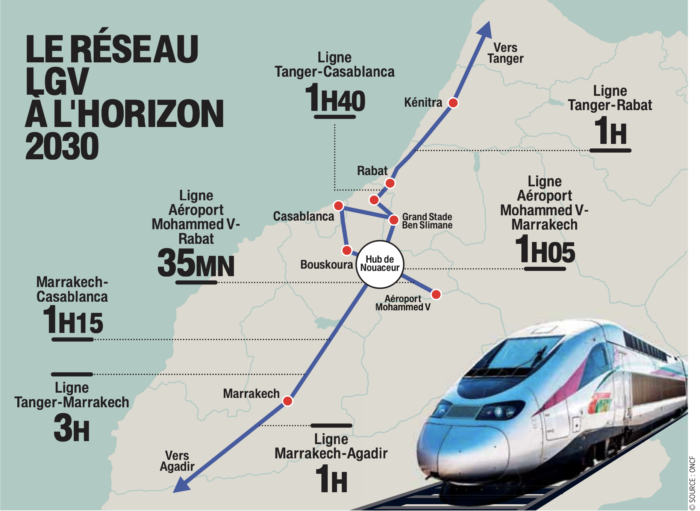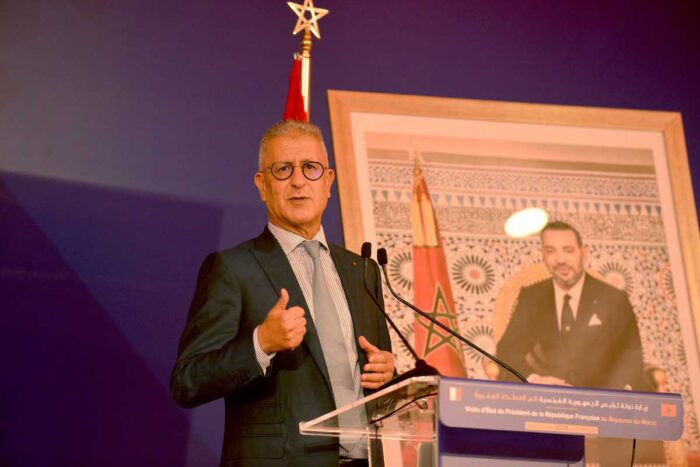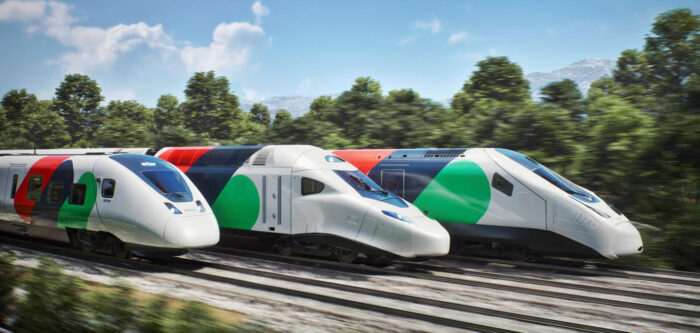Ever since King Mohammed VI and former French President Nicolas Sarkozy launched work on Morocco’s first high-speed line (LGV) in 2007, « one question has long been asked« : « Can a middle-income country afford a high-speed line? Today, the answer is yes« , said Mohamed Rabie Khlie, Managing Director of the National Railways Office (ONCF, Office National des Chemins de Fer), at a joint press briefing with Alstom CEO Henri Poupart-Lafarge in Rabat on Tuesday October 29.
Praising Al Boraq’s performance since its inauguration in 2018, the ONCF executive assured that all the LGV’s figures are now in the green. « Beyond the performance in terms of service quality and satisfaction, which exceeds a rate of 98%, and a regularity rate of 97%, the operating margin is practically in the range of what is observed in Europe, if not more, » he enthused.
A trip on Al Boraq between Casablanca and Tangiers starts at 149 dirhams, although prices vary according to the time of purchase and the date of travel. « It’s true that the price of a Moroccan ticket is lower than the price of a European ticket, but we have a highly optimized operating model, which enables us to achieve this operating margin« , explained Rabie Khlie.
40% of lots awarded before the end of 2024
At present, Morocco « intends to continue this adventure to add 400 km of high-speed line between Kénitra and Marrakech, which will enable us to have, before the World Cup, something like 600 km of high-speed line« , asserted the ONCF boss.
He added that the Kénitra-Marrakech high-speed line « is part of a much more global and integrated project, which will total some 8 billion euros between 2024 and 2030

In addition to the new LGV, this project also includes the upgrading of conventional networks and the acquisition of additional trains to renovate the current fleet.
Concerning the Kénitra-Marrakech LGV, « almost 60% of the lots » have already been awarded following international calls for tender, « whether for the civil engineering part, the railway equipment part, or the systems part« , explained Rabie Khlie.
According to him, the remaining 40% are « in the process of being awarded » and will all be awarded « before the end of the year« .
In the long list of strategic agreements signed between Morocco and France during Emmanuel Macron’s state visit to Rabat, the first four to be officially announced concern the new TGV high-speed train.
« As you can see, we signed the contract for the high-speed section with our partner Alstom, because their offer was the most competitive, in terms of the cost of the train, the maintenance and logistical support provided throughout the life of the trains, the strong industrial compensation component and the support of the French Treasury with a soft loan to finance these trains« , explained the ONCF CEO.
Alstom’s CEO « happy » with the deal
The CEO of Alstom, a « formidable negotiator » according to Rabie Khlie, thanked the ONCF for allowing his company to « take part in this adventure » and in the « development of very high speed rail in Morocco« . He also said he was « happy in many ways« , not least because « the whole world will be coming to use these trains during the 2030 World Cup« .

« Alstom has a strong presence in Morocco, and Morocco is an extremely important country for Alstom, not just because there are commercial prospects and very important markets, but also because we are counting on Morocco as an industrial platform, » continued Henri Poupart-Lafarge. In particular, he cited Alstom’s Fez site, where he has « invested heavily in recent years« , to the tune of over 20 million euros. « This site is an absolutely major part of Alstom’s industrial base, because it is one of the two Alstom sites in the world that makes wiring, transformers and cockpits« , he stressed.
Commenting on the Kénitra-Marrakech LGV contract, Alstom’s CEO underlined his « very great joy » at having been chosen, following an « extremely positive call for tenders which validates the performance of (their) trains« .

According to him, for this new project, it will be Avelia, Alstom’s very latest generation of train, which has « the best performance on the market in terms of total cost of operations and running costs » and which « features all the most modern equipment available, since it is just coming out of our factories« .
4 agreements signed
On the evening of Monday October 28, ONCF signed a total of four agreements before King Mohammed VI and Emmanuel Macron at the Royal Palace in Rabat. The first was a memorandum of understanding for the supply of high-speed trains and their support components, signed with Henri Poupart-Lafarge. It provides for the acquisition of 18 trainsets for the new TGV, including 12 confirmed sets and 6 optional ones.
The second is a declaration of intent concerning financial cooperation in the rail sector, signed by the Minister of Economy and Finance, Nadia Fettah Alaoui, her French counterpart Antoine Armand and Mohamed Rabie Khlie.
The third agreement concerns an assistance contract between ONCF and the Franco-Moroccan Systra/Egis/Novec consortium, covering the management of infrastructure projects for the Kénitra-Marrakech LGV. Finally, the fourth agreement is a contract for the supply of turnouts, signed with switch specialist Vossloh Cogifer for the same project.
Written by Ghita Ismaili. Edited in English by S.E.




